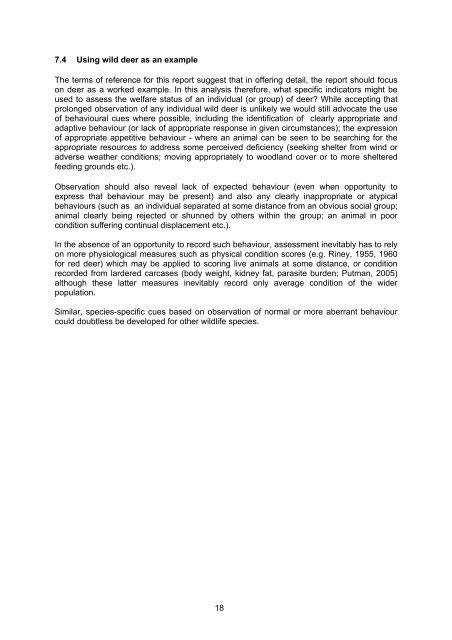Applying wildlife welfare principles to individual animals
Applying wildlife welfare principles to individual animals
Applying wildlife welfare principles to individual animals
You also want an ePaper? Increase the reach of your titles
YUMPU automatically turns print PDFs into web optimized ePapers that Google loves.
7.4 Using wild deer as an example<br />
The terms of reference for this report suggest that in offering detail, the report should focus<br />
on deer as a worked example. In this analysis therefore, what specific indica<strong>to</strong>rs might be<br />
used <strong>to</strong> assess the <strong>welfare</strong> status of an <strong>individual</strong> (or group) of deer? While accepting that<br />
prolonged observation of any <strong>individual</strong> wild deer is unlikely we would still advocate the use<br />
of behavioural cues where possible, including the identification of clearly appropriate and<br />
adaptive behaviour (or lack of appropriate response in given circumstances); the expression<br />
of appropriate appetitive behaviour - where an animal can be seen <strong>to</strong> be searching for the<br />
appropriate resources <strong>to</strong> address some perceived deficiency (seeking shelter from wind or<br />
adverse weather conditions; moving appropriately <strong>to</strong> woodland cover or <strong>to</strong> more sheltered<br />
feeding grounds etc.).<br />
Observation should also reveal lack of expected behaviour (even when opportunity <strong>to</strong><br />
express that behaviour may be present) and also any clearly inappropriate or atypical<br />
behaviours (such as an <strong>individual</strong> separated at some distance from an obvious social group;<br />
animal clearly being rejected or shunned by others within the group; an animal in poor<br />
condition suffering continual displacement etc.).<br />
In the absence of an opportunity <strong>to</strong> record such behaviour, assessment inevitably has <strong>to</strong> rely<br />
on more physiological measures such as physical condition scores (e.g. Riney, 1955, 1960<br />
for red deer) which may be applied <strong>to</strong> scoring live <strong>animals</strong> at some distance, or condition<br />
recorded from lardered carcases (body weight, kidney fat, parasite burden; Putman, 2005)<br />
although these latter measures inevitably record only average condition of the wider<br />
population.<br />
Similar, species-specific cues based on observation of normal or more aberrant behaviour<br />
could doubtless be developed for other <strong>wildlife</strong> species.<br />
18

















